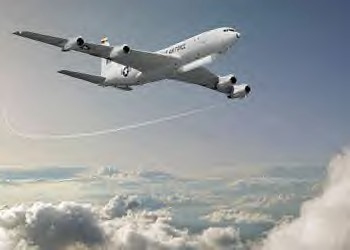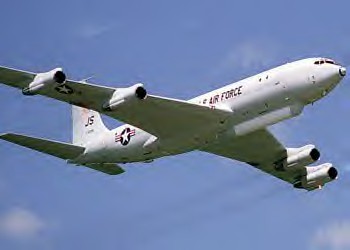The E-8C Joint Surveillance Target Attack Radar System (Joint STARS) is an airborne battle management, command and control, intelligence, surveillance and reconnaissance platform. Its primary mission is to provide theater ground and air commanders with ground surveillance to support attack operations and targeting that contributes to the delay, disruption and destruction of enemy forces.
The E-8C is a modified Boeing 707-300 series commercial airframe extensively remanufactured and modified with the radar, communications, operations and control subsystems required to perform its operational mission. The most prominent external feature is the 40-foot (12 meters) long, canoe-shaped radome under the forward fuselage that houses the 24-foot (7.3 meters) long, side-looking phased array antenna.
The radar and computer subsystems on the E-8C can gather and display detailed battlefield information on ground forces. The information is relayed in near-real time to the Army’s common ground stations and to other ground command, control, communications, computers and intelligence (C4I) nodes
The antenna can be tilted to either side of the aircraft where it can develop a 120-degree field of view covering nearly 19,305 square miles (50,000 square kilometers) and is capable of detecting targets at more than 250 kilometers (more than 820,000 feet). The radar also has some limited capability to detect helicopters, rotating antennas and low, slow-moving fixed wing aircraft.
As a battle management and command and control asset, the E-8C can support the full spectrum of roles and missions from peacekeeping operations to major theater war.
 Joint STARS evolved from Army and Air Force programs to develop, detect, locate and attack enemy armor at ranges beyond the forward area of troops. The first two developmental aircraft deployed in 1991 to Operation Desert Storm. The joint program accurately tracked mobile Iraqi forces, including tanks and Scud missiles. Crews flew developmental aircraft on 49 combat sorties, more than 500 combat hours with a 100 percent mission-effectiveness rate.
Joint STARS evolved from Army and Air Force programs to develop, detect, locate and attack enemy armor at ranges beyond the forward area of troops. The first two developmental aircraft deployed in 1991 to Operation Desert Storm. The joint program accurately tracked mobile Iraqi forces, including tanks and Scud missiles. Crews flew developmental aircraft on 49 combat sorties, more than 500 combat hours with a 100 percent mission-effectiveness rate.
Joint STARS developmental aircraft were also called to support Operation Joint Endeavor, in December 1995. Crews flew 95 consecutive operational sorties and more than 1,000 flight hours with a 98 percent mission effectiveness rate. While monitoring treaty compliance as NATO rotated troops through Bosnia-Herzegovina in 1996, the first production E-8C and a pre-production E-8C flew 36 operational sorties and more than 470 flight hours with a 100 percent effectiveness rate. The 93rd Air Control Wing accepted its first aircraft, June 11, 1996, and declared initial operational capability Dec. 18, 1997.
Operation Allied Force saw Joint STARS in action again from February to June 1999 logging more than 1,000 flight hours and a 94.5 percent mission-effectiveness rate.
The wing deployed to Operation Enduring Freedom from November 2001 to April 2002, flying 247 combat sorties with a 98.4 percent mission-effectiveness rate.
All E-8C aircraft are assigned to the 116th Bomb Wing of the Georgia Air National Guard, Robins Air Force Base, Ga. The unit is the first Total Force wing -- combining Guard and active-duty airmen from the inactivated 93 ACW into a single unit.
 Manufacturer: Grumman/Boeing
Manufacturer: Grumman/Boeing
Powerplant: Four Pratt and Whitney TF33-102C
Thrust: 19,200 pounds each engine
Length: 152 feet, 11 inches (46.6 meters)
Height: 42 feet 6 inches (13 meters)
Wingspan: 145 feet, 9 inches (44.4 meters)
Speed: Optimum orbit speed 390 - 510 knots (Mach 0.52 - 0.65)
Ceiling: 42,000 feet (12,802 meters)
Maximum takeoff weight: 336,000 pounds (152,409 kilograms)
Range: 9 hours (unrefueled)
Unit Cost: $244.4 million (fiscal 98 constant dollars)
Crew: Flight crew of four plus 15 Air Force and three Army specialists (crew size varies according to mission)
Date Deployed: 1991, 1996
Inventory: Total Force wing, 14; Reserve, 0
